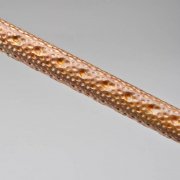Two-Phase Heat Transfer of R410A in Annuli Outside Enhanced Tubes With Micro-Fin and Dimple
An experimental study of two-phase heat transfer using R410A in the annuli outside tube-in-tube heat exchanger was performed using several enhanced tubes; performance was compared to the performance of a smooth tube. Condensation experiments (using R410A) were conducted at a saturated temperature of 45 °C. Mass flux ranged from 75 to 225 kg m-2 s-1; with inlet vapor quality of 0.8 and outlet quality of 0.2. Evaporation experiments were conducted at saturated temperature of 6 °C using R410A; with a mass flux ranging from 75 to 225 kg m-2 s-1; inlet vapor quality of 0.2 and outlet quality of 0.8. The heat transfer coefficients of condensation and evaporation outside the smooth tube were compared with the existing correlations. The major conclusions are summarized as follows:
- Evaporation heat transfer characteristics of the enhanced tubes tested show that as mass velocity increases, the heat transfer coefficients also increase; the EHT HB-D tube produces the best thermal performance; its heat transfer coefficients are 1.54 to 2.23 times higher than that of the smooth tube.
- In a comparison of condensation heat transfer performance of the HB tube to the DIM/HB tube lower performance is observed in the DIM/HB tube at low mass flux rates; as the mass flux is increased, the dimple structure gradually changes from obstructing heat transfer to enhancing heat transfer. As the mass flow rate increases, the disturbance caused by the dimple structure circulates the retained refrigerant and enhances the heat transfer. The EHT HB-D tube has the best heat transfer performance (especially at high mass flow rates).
The complete publication can be found, here.



Leave a Reply
Want to join the discussion?Feel free to contribute!